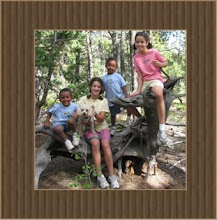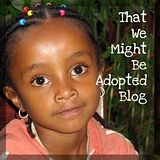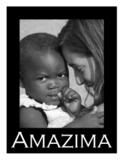100 things about Ethiopia (from another great adoptive mom)
1.One out of every 20 children born alive die in their first month of life
2. One out of ten die before reaching their first birthday
3.One out of six die before reaching their fifth birthday
4 There are 4.6 million orphans in Ethiopia
5. The median age in Ethiopia is 16
6. 1.5 million people in Ethiopia are infected with AIDS
Per capital, Ethiopia receives less aid than any country in Africa
Ethiopia is one of the few African countries never to lose its independence.
7. It is as large as France and Spain combined and has one of the richest histories on the African continent.
8. People
Ethiopia has a total population estimated at approximately 70 million and is home to more than 80 ethnic groups and a wide diversity of languages.
9. Religion
The major religions are Christianity (mainly Orthodox Church) and Islam
10. Amharic is the official language of Ethiopia some indigenous languages are Oromo, Tigrinya and Somal
11.The local currency is the Ethiopian Birr, which is made up of 100 cents
12. Ethiopian Calendar: the Julian Calendar, in which the year is divided into 12 months of 30 days each, and a 13th month of five days and six days during the leap year. The Ethiopian Calendar is almost eight years behind the Gregorian calendar.
13. 90 percent of the country’s residents earn their living as subsistence farmers. They grow just enough food to feed their families
14. Only 31 percent of children between the ages of 7 and 15 attend school.
15. Average Income $160 annually
16. Access to safe water 22%
17. Literacy rate 42%
18. Infant mortality rate 109/1000
19. Life expectancy 49
20. Wildlife is abundant in Ethiopia. It is home to monkeys, antelopes, hyenas, warthogs, and more than 100 types of birds. Elephants, lions, and giraffes live in some areas.
21. Homeland of Coffee
22. Coffee accounts for 50% of their exports
23. Ethiopian Birr (=$0.113)
24. Maternal mortality: 673 per 100,000 live births
25. Number of television stations: 1
26. Number of internet service providers: 1
27. Ethiopia borders Kenya, Somalia, Sudan, Eritrea and Djibouti
28. Ethiopians Celebrated the year 2000 (this September 2007)
29. Lucy is a 3.18 million-year-old fossil of an early ancestor of humans. She weighed about 60 pounds and stood erect around 3 feet.
30. the hottest place in the world is Dalol, Ethiopia with an average temperature of 94.3F/34.6c
31. Ethiopia is the 5th poorest country in the world
32. the ancient Ethiopian monarchy maintained its freedom from colonial rule, one exception being the Italian occupation of 1936-41
33. The national clothes are basically white, whether the shawls and light blankets worn over the shoulders by the men or the white dresses and wraps worn by the ladies
34. Meskal is a two-day festival at the end of September celebrating the Finding of the True Cross. Bonfires are lit and singing and dancing take place around them, while the priests don their full ceremonial regalia.
35. Timkat usually falls on the January 19, 12 days after Christmas according to the Julian calendar. It is a colorful three-day festival celebrating Epiphany and it is marked by the procession of the tabots (the replicas of the Ark of the Covenant, the original of which is said to be in the chapel at Axum) around the towns, draped in heavy embroidered materials.
Typical foods
36. Doro Alicha - mild Ethiopian chicken dish
37. Doro Wat - A spicy Ethiopian chicken dish
38. Tibs Wet - A very spicy (and fatty!) meat dish from Ethiopia
39. Injera Bread - A very simple recipe for injera, the pancake-spongy bread that accompanies Ethiopian food.
40. Spiced butter ((Niter Kebbeh))A recipe for clarified, herbed butter, a basic ingredient in Ethiopian cuisine
41. Berbere A red-pepper based spice mixture, used in Ethiopian dishes
Music
42. The krar are harps while another more fiddle-like instrument is known as masenko.
43. Kebaro Very common in popular and religious music is the kabaro or kebero. When the women and men dance in their beautiful white robes they dance on the rhythm of the drums
Grief
44. Upon the death of a family member, family would express their grief openly by crying loudly and beating their chests.
45. scrape a thorny fruit across their faces
46. Both women and men would usually shaved their heads and wore black clothing.
47. DAY 3: Family and friends once again visit the home of the deceased, bringing food and drink
48. DAYS 40, 80, 180: On each of these days after the death, family and friends will bring food and drink and gather at the church or grave site to memorialize the deceased. The food would include a container of injera (a very thin type of pita bread), a container of wot (a type of stew) and homemade bread. The priests would cut the bread and pass out to beggars and others at the church (deacons, other priests, etc.). It was considered a good thing to give food to the poor and "forgotten" in honor of the deceased.
49. ANNUALLY: On the annual date of the death, a memorial service such as the ones mentioned above took place, with food being brought to the church, shared with beggars, etc. If the family was affluent, they might have the ceremony at their home instead of at the church. After the first anniversary of the death, people usually stopped wearing black and allowed their hair to grow back.
50. THE SEVENTH YEAR: At the seventh anniversary of the death, a feast would be held at the church or, if affluent, at the home. A goat or other livestock would usually be butchered and homemade ale would be brought. The ceremony was like the others, but on a larger scale. This point seems to be the maximum for mourning; after this, the annual ceremonies cease.
51. Shoes should be removed before entering mosques and churches
52. Photographs should not be taken of military buildings and airports, and permission should be asked before photographing religious festivals and people.
53. Tourist hotels and restaurants usually add a 10% service charge to the bill. Otherwise tipping is fairly common, but only small amounts are customary.
54. The Great Run - Nov 18th (my birthday is an Ethiopian holiday)
It is not a religious holiday but a big running event among the biggest and first of its kind in Africa, held in the month of November every year.This event was pioneered by Haile G. Selassie, the greatest long distance runner in the world and most famous for his numerous athletic records. People of all ages numbering 25,000 or more participate in this great international event, counting it as a great joy and privilege to run with world class athletes.
55. Coffee ceremony
For the visitor a real and exotic experience will be to take part in this traditional coffee ceremony accompanied by freshly cut grass scattered on the ground, burning incense and coffee beans roasting in a pan.As the smoke rises you’ll be offered the delicious aroma, to draw toward you and inhale.The beans are then ground with a pestle and mortar and brewed with water in a pan. When it is finally ready, the coffee is served in tiny cups in three turns served with ‘Buna-kurse’ a small snack, usually popcorn is the other part of what is a beautiful ceremony.
56. http://www.youtube.com/watch?v=Bk6zf6LTrng
Ethiopian Culture
57. http://www.youtube.com/watch?v=_T53SIU14Z0
Children Dying
58. http://www.youtube.com/watch?v=sJp4QZZfLuc
We Will Never Forget
59. http://www.youtube.com/watch?v=c3L8rZJcKd8
Ethiopia, A Closer Look at Ethiopian Adoption
60. http://www.youtube.com/watch?v=vEnWk9kjZlU
"I Saw What I Saw"
61. http://www.youtube.com/watch?v=dHpdrncqaBg
One Hope: A Story of Ethiopian Orphans
62. http://www.youtube.com/watch?v=8zQYA6OgyuM
Africa Ophans - A Message From Rick Warren
63. http://www.youtube.com/watch?v=Re026MmrDz8
Silas' First Phone Call
64. http://www.youtube.com/watch?v=5IOdD6V0iTc
Touching Ethiopia
65. http://www.youtube.com/watch?v=iA0yCv-3amY
Touching Ethiopia - Part Two
66. http://www.youtube.com/watch?v=yKVTeigvaeA
Our Adoption from Ethiopia
67. http://www.youtube.com/watch?v=Xyx_9qfsnIU
Mission Ethiopia
68. http://www.youtube.com/watch?v=OuoAuAjBEAE
2008 Mission Video: Planting in Ethiopia
69. http://www.youtube.com/watch?v=4nEcl4E17S0
Ethiopia's Street Children
70. http://www.youtube.com/watch?v=Bp7RlshPs9s
"Mesgana" Dancers 2007 Tour - Concert Interlude #2
71.
Hannas Orphan Home
72. http://www.youtube.com/watch?v=jhvVnvSGntA
Addis Ababa - The Zone Activity Week - Part 01
73. http://www.youtube.com/watch?v=N5o7yTjqiAE&feature=related
Addis Ababa - The Zone Activity Week - Part 02
74. Ethiopian market in SLC African Treasure Market located at 1532 South State, Salt Lake City, UT 84115.
75. Colorado heritage camp http://www.heritagecamps.org/afam.html
76. Ethiopian Camp http://www.africancradle.org/campfees.html
77. African Restaurant & Mini-Mart
1878 S Redwood Rd, Salt Lake City, UT 84104
Yahoo groups
78. adoptionhair_skincare
79. AHOPEforchildren
80. CAFEKids
81. Christian-International-Adoption
82. ethio-utah
83. EthiopiaAAR
84. EthiopiaAdopt
85. ethiopianadoptionconnections
86. single-adopt-ethiopia
87. UtahTransracialAdoption
88. WACAPETHIOPIANADOPTION
89. Ethiopia books http://www.amharickids.com/
90. Ethiopian Names Website
http://www.gaminggeeks.org/Resources/KateMonk/Africa/Eastern/Ethiopia.htm
91. Ethiopian Newspaper in English http://www.addisfortune.com/
92. http://ethiopiasfinest.com/ Fair trade coffee
93. http://www.abshirokids.com/ Music, books, kids games
94. Ethiopian embassy USA
http://www.ethiopianembassy.org/index.shtml
95. US embassy Addis Ababa
http://ethiopia.usembassy.gov/
96. http://wwwn.cdc.gov/travel/destinationEthiopia.aspx
CDC’s recommendations for travel
97. AHOPE
Website for AHOPE organization
http://www.ahopeforchildren.org/
98. Medical testing
http://www.fwcc.org/pediatricexam.html
99. http://www.fromhivtohome.org/
100. http://www.redletterscampaign.com/
Saturday, April 4, 2009
Subscribe to:
Post Comments (Atom)
Guest house gives back
Sponsor a Child
Disclaimer
The content on The Wayfarer:Ethiopian Adoption Resource Blog is for informational purposes only. We are adoptive parents, but we are not professionals. The opinions and suggestions expressed here are not intended to replace professional evaluation or therapy, or to supersede your agency. We assume no responsibility in the decisions that families make for their children and families. There are many links on this blog. We believe these other sites have valuable information, but we do not necessarily share all of the opinions or positions represented by each site, nor have we fully researched every aspect of each link. Please keep this in mind when visiting the links from this page.
Thank You.
Thank You.
A Links Disclaimer
I post a lot of links. I do so because I feel that the particular page has good information and much to offer. I do not necessarily support all that each site has to say or promote. I trust you to sift the links for information you feel is worthwhile to you. Each person's story and situation are unique and different things will be useful or not useful to each one in different ways. Please use your own discretion when accessing links and information.











































No comments:
Post a Comment
Please leave a comment: